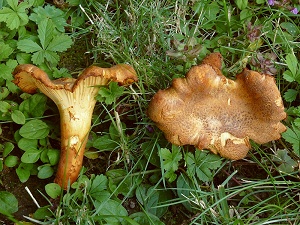| Cantharellus amethysteus (Quél.) Quél. |
|
|
|
|
|
|
The cap is dull orange or yellow, covered at the disk with small downy purple scales, sometimes on the whole cap, up to giving it an overall purplish colour, convex to funnel-shaped, then depressed at the centre; its margin is incurved a long time, then irregular, thick, lobed and wavy. The cap surface is finely scaly at the disk or on the whole cap, dry, downy. The stem is pale yellow, turning yellow when manipulated, tapering at the base, without ring. The flesh is white to pale cream-yellow, turning orange-brown when exposed to air; its taste is mild to slightly bitter; the odour is faint, fruity, of apricots; its texture is fibrous. The gills are dull ochre-yellow, sometimes with pink shades, but these are not gills, but folds or ridges, quite distant, decurrent and forked . The spore print is white. This species is mycorrhizal. It grows on the ground, in broad-leaved woods mostly (rarely with conifers), on a rather acid or hardly calcareous soil, more often in mountainous regions, with beech, also with oak and birch, rarely with pines. The fruiting period takes place from June to November.
Distinctive features : Dull orange-yellow cap, covered at the disk with small, purple-lilac downy scales, sometimes covering it all to give it a purplish colour; stem turning tawny yellow when manipulated; no gills under cap but ridge-like folds instead, dull yellow, decurrent and distant; with deciduous trees Cantharellus amethysteus is still unreported so far in the forest of Rambouillet, and is quite rare, more generally speaking .
page updated on 14/01/18 |
